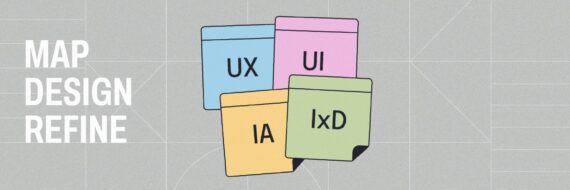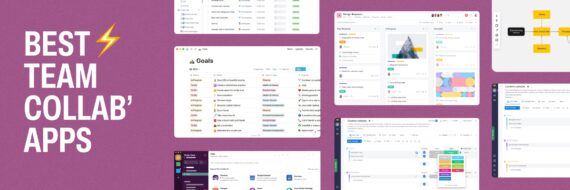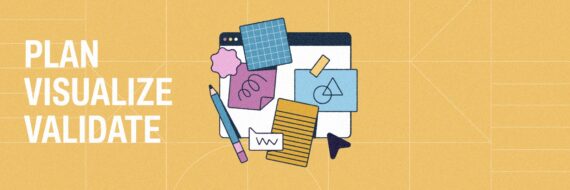UX design is a continually evolving field, and there’s one clear process that supports those ideas flowing, and it’s a simple concept: research. There’s a world of UX research methods at a designer’s fingertips that allow them to tap into what end-users think while providing amazing insights to push UX further.
Choosing and implementing the proper methods can be a game-changer. A time-saver. A moneymaker. A money-saver. All the big names are using these tools; that’s precisely why they’re household names. But the truth is, anyone can do this. Netflix didn’t get where they are by taking guesses. They used their resources, and you can too.
What is a user research method?
A user research method is a research process used to better understand and utilize your users’ wants, interests and needs, along with their behaviors, mindsets and what motivates them to get those things.
These methods are used to better understand what users see and experience a product, obtain benchmarking data and eliminate some of the pain points users might experience before a final product is released.
How many types of UX research methods are there?
While there isn’t an exact number, there’s somewhere in the realm of 15 to 20, which are most commonly used among design teams. More concretely, all of those different types of UX research methods fall into four broad categories; generative research, descriptive research, evaluative research and casual research. UX design depends on the valuable insights these testing methods produce; it makes the design process more efficient. Many design decisions will be directly related to the results of this research. What is UX design, anyway? You’re in luck; we’ve got the scoop on everything you need to know.
🎬 Learn what Slickplan can do!
We filmed a short video to show you exactly how to use Slickplan
What are the different types of user research methods?
In the following UX research methods list, we’ll go deeper into the six more important real-life tests, what they mean and how to use the different types of user research methods. Of course, plenty more tests are available to suit your needs and, ultimately, your users’ needs, but these are some of the most commonly used ones.
1. A/B testing/split testing

A/B testing is simple but effective. Subjects are shown two variants of the same thing (website, app, object, etc.) Between the two, there can be differences such as background colors or fonts, different button sizes or shapes, and the list could go on forever. The goal here is to determine which performs better. Performance, in this instance, can mean anything from which one the people liked better to which one people would be more likely to click on.
More on this below.
When to use this UX research method
This test has endless uses so long as you can come up with variations to provide people and a question for them to answer. As we continue to develop what UX can do, this type of test will become especially helpful in IxD or interaction design situations, but it can also be as simple as "are you more likely to buy if you saw this screen or this screen?"
If you need the core interaction design (IxD) definition, our design terms glossary covers it.
2. Remote usability testing

Usability testing is very direct testing. You are literally unleashing a product on your target audience and demographic users to see how they interact with it. "Remote" refers to the fact that this is an unmoderated test, i.e., you’re not directly standing there and watching someone use your product, and it can be done right from where your customers already are. The beauty of this type of testing is other tests can be worked into this one. For example, while working remotely, multiple of these tests can be administered at once for more bang for your buck. It’s a cost-efficient, high-impact test that can be administered to a large or small group with ease. More on usability testing metrics and what they mean for your product.
When to use this UX research methodology
This is a great tool when a large number of users and feedback are a top priority. Of course, more is usually always better, but if physical space for users to gather is a problem, the product is available online, perhaps there’s a worldwide pandemic, or you just like staying home and working in bed binging on Thai delivery while listening to the Grease soundtrack on repeat, remote is the way to go. Everybody’s homes just became your lab with this UX research methodology.
3. Diary studies/camera studies

A diary or camera study is pretty much what you may think. It’s written or recorded feedback from your test user’s perspective about their thoughts and feelings regarding a product. To take it a step further, this is an excellent chance to collect some user stories and get them filed away in Jira. Just remember, user stories aren’t written by the user; rather, they’re based on the information the user submits to you.
In a diary/camera study, your users can give real-time feedback, which ends up being a more candid experience rather than a summarized/edited down experience.
When to use this user research method
This method can be used in person with test groups or remotely. Be prepared for a lot of data if the chosen format is through a camera lens. People who heavily use social media (TikTok, YouTube, etc.) will be comfortable in front of a camera and giving feedback; people love to talk. But… everything has to be watched and filed. If you don’t have the time or enough (wo)manpower, this is not the method for you.
4. Field studies

A field study is product user research conducted where the product is being in "the field" and in context, rather than in a lab setting. An example outside of computer UX could be a sample station at the grocery store. People usually get excited to see them and try a few things, but this would likely have a different feel in a lab setting. You’re more likely to buy the product in one of these situations.
When to use this UX research method
To put it bluntly, field studies can be used when there are enough people to warrant trying to pull it off. Making sure enough test subjects are available where the product would be relevant and enough people on the team to be flies on the wall to take in all the information is what makes this work.
5. Questionnaires/surveys

You’ve probably been part of one of these a few times. This is the simplest and most efficient (also the cheapest) way to gather user research data. For example, this might be a few questions after a product is used or a list of questions to answer while using the product in real time.
When to use this UX research methodology
Due to the simplicity, so long as the questions/surveys are well put together and are easy to understand and answer, these can be used pretty much every time user research is needed (ideally alongside other methods).
6. Five-second testing

This is another straightforward yet informative test. Sadly, as a species, our attention span has decreased significantly over the years. Gone are the days of 12-minute Lynyrd Skynyrd guitar solos during Freebird. But, a lot can be gathered in five seconds or less. Have you ever pulled up a website and immediately thought, "eh, never mind"? Ever opened an app, and it just took way too long? Delete. That’s the stuff we’re looking for here — immediate thoughts, first impressions, in five seconds or less.
When to use this UX research method
This is typically used in a lab setting so the product can be controlled in a way that the user is given no more than five seconds. Quite literally, "what do you think" and "how does it make you feel"?
What is the best user research methodology?
Choosing the best user research methodology, like many things in user experience design, comes down to your needs. All of these methods are important, but the better question would likely be which types of tests are the best for what you’re doing.
Again, it’s about what you seek to learn in order to better your product. A/B testing will yield different results than user interviews and eye tracking. All of these have their place in research; you need to know how to use them to get the most out of them. And as luck would have it, you’ve come to the right place.
Choosing the right UX UI research for you
UX UI research requires knowing when to pick the right tools to get the job done. This is a pivotal moment in the product design process and an excellent chance to put the stakeholders at ease. Real-world test participants and the results they produce can shape a product or app so long as you know what to do with the data and can apply it correctly.
Picking the appropriate method is often an exercise in deciding which type of feedback will help you the most. Feedback falls into four categories; quantitative, qualitative, behavioral and attitudinal. It might seem a bit confusing, but as we go along, it should begin to make more sense, and you’ll get an idea of how they all relate and work together.
Remember those four categories we mentioned at the top? Well, they sort of all bleed together. There are no hard lines. Imagine one of those online surveys about politics (Facebook, Buzzfeed, etc.); after answering several questions, you end up placed on a graph that shows where you land on the political spectrum. The methods for user research can work like that. The point of mentioning this is to illustrate that although something might be defined in a category type, it reaches into other areas.
Quantitative research
User testing via quantitative research consists of raw and objective numerical data. The questions and tests can be about anything as long as the answer comes in the form of numbers. You define those numbers through later testing.
This UX research method tells you how much or how many of something. Why is that important? Because if only one person feels some kind of way about something, you know it isn’t time to hit the panic button. One user doth not a bad product make. That person can air their complaints in other categories. But if a trend is created where 40% of people delete your app in less than a week — it’s time for your design team to panic…
So why are numbers even that important, especially if you can (for now) look past one or two bad pieces of numeric feedback? Simple. Can you think of an app or service you don’t like that the general public loves? You’re the unpopular opinion. That doesn’t make it a lousy product. Not everything is for everyone, and this method helps find relevant trends in what more significant numbers think or say about a product. You’re allowed to feel that way, but in the grand scheme, you’re only one voice.
Qualitative research
Qualitative research is the collection of non-numeric data about users and a product. These are opinions, thoughts, comments and concerns about a new product. They’re also helpful in improving an existing product or gathering ideas and insights for a future project.
Behavioral research
Simply put, behavioral user research takes a hard look at what users do in specific situations. Think of it like an "if this, then that."; if we give you this, then you’ll do [blank]. This process defines a user’s behavior when given tasks and ways to complete them. It provides quick and valuable feedback because if you meant for people to do something entirely different, you know there’s a problem. The solution may have been obvious to you as the designer, but it’s a failure if it doesn’t work in practice. This provides quantitative data that’s important to the process.
Keep in mind that this is used when you have a large number of users to monitor and gather data from. Picking five people to run a task is not ideal. You may get five different answers. However, clear and actionable patterns can emerge when a larger number of participants are involved.
Attitudinal research
Attitudinal research is a bit more direct in terms of feedback. This method assesses users’ actual thoughts and feelings about a product or experience and can be used anytime. During product development. Before launch. After launch. Continued research about a product or brand. These can be through interviews, card sorting, surveys, focus groups, etc. Even those Twitter complaints can be used as attitudinal research.
When to use UX research methodologies
Along with having a solid understanding of what kinds of UX research methodologies are available, knowing when to call on certain ones can make all the difference when working with a group of users. Product teams rely on humans to test products in a natural environment which can help eliminate some of the biases that user personas can create. With that being said, you should start getting a clearer picture of why user research is so vital to the development process.
New product development
When a new or minimum viable product is being developed, long before you bother with information architecture or wireframes and dive into UX strategy, user research should be conducted to avoid wasting time and resources. This is the time to eliminate preconceived ideas or incorrect information that can cause delays or unnecessary design and feedback loops.
Product launch
Once a product is launched, if there’s time to lean, there’s time to clean. User research and testing can still be done for sprucing up a final product. This ties directly into updates and future versions. If you’re not paying attention, you’ll have no idea what people love or what and where to go from there.
Future versions
Future versions consider the preceding information and continue collecting more data. This can be data showing what not to do or data you may want to research further into to create the best —next— version of whatever the product is. There’s a wrong way to do this, though, and that’s to completely ignore any data obtained from previous research.
6 benefits of user research methodologies
While there really could be a million reasons why user research methodologies are beneficial to your project/product, we’ve selected the top six reasons. If the last three on this list aren’t enough to convince you, we recommend quickly pulling yourself together to reevaluate what your priorities are in your business goals.
1. It’s pretty open-ended.
User research isn’t a strict process. You’re free to run things (mostly) how you see fit. There are, of course, better ways of doing things, and you shouldn’t just go in haphazardly and start asking strangers questions. For the most part, though, everything can be suited to your needs.
2. Lots of results
The more people you have testing and answering during this research process, the more data you have to work with. There are tons of resources out there to get research subjects, and if you have an existing brand, you probably already have a list of people to help with research. Not everyone will want to participate, but look at Apple’s beta program; they have public and developer-only versions (some people even pay to get developer betas that aren’t developers). All in all, there will always be people that are willing to do this type of work.
3. Quick yet valuable
Most of the tests are pretty simple, so a lot can be combined, allowing for not only a lot of results but a lot of results coming in quickly — gold star for efficiency here. Quick and simple can also translate to a lower cost. Quick, cheap and valuable results. That’s like every stakeholder’s dream.
4. Fewer problems passed on to customers
The next three are all related and, on their own, are enough reasons to never skip user research.
When kinks and issues get worked out before launch, customers can focus on how happy they are with their purchase or subscription. The problem areas were primarily addressed before it ever locked eyes with a paying customer, which is always a plus.
5. Happier customers
With all those issues resolved, people are happier with your product, and the brand becomes more and more trustworthy. People see you as a quality offering. And happier customers create…
6. Better revenue (potentially)
All those happy people are spending money. Have you ever known or loved a product so much that you basically just slapped the money down when a new one came out? You know it’ll be great, and you have complete faith in that? Some brands you know and love will be great, even with a problem here and there. They know it, too, and they love your revenue. So they put a lot of work into ensuring the product got to that point in your mind.
6 tips on implementing user experience research methods
We’ve compiled a list of six user experience research methods, six reasons why you should definitely use them and now six ways to implement them into your project.
1. Identify the what and why
What needs testing (product, app, object) and why (is it new, outdated, or are there issues)?
2. Find your target audience
Determining your product demographic is enormous. People respond to different things in different ways, and if you’re marketing a product to the wrong group, you’re wasting a lot of time and a ton of money.
3. Select your tasks
This is where you get to take any and all tests you’ve ever heard or thought of and pick your favorites. From there, you can decide which will benefit the product you’re testing for and sculpt them to fit those needs.
4. Invite the right testers
This should mimic your target audience (which is why it was essential to determine who that audience is). There’s lots of research and guides available in the wild regarding finding the right test participants, and they’re all out there and pretty easy to find to make your data more accurate.
5. Get those stakeholders in on it
Sometimes they want in on the process too, and it never hurts to continue to instill confidence in the people cutting the checks.
6. Implement
All the user research in the world is lovely, but if you don’t implement it and make good on it, it was all for nothing. You might’ve really loved a design choice when you thought up the product but the people hated it. That’s life. Be ready to let go of some of those feelings because this is business. If the stakeholders don’t have confidence in you, they’ll find someone they do.
UX research techniques: our conclusion
As mentioned, many more UX research techniques are out there, and they’re worth looking into. Most of them are just as easy as the ones we highlighted and can be used by anyone as long as you adapt them to fit your needs and what you aim to learn. Use your time wisely and use effective methods to get the most effective data in return.
Think visually. Improve UX with Slickplan
Build intuitive user flows, stronger customer journeys and improve information architecture.
FAQs on UX methodologies
What is a UX research example?
A UX research example can be any sort of test or type of research evaluated by UX professionals involving a user paired with a physical product, app or service for evaluation. This can be something as simple as diary studies and as in-depth as remote usability research.
Which user research techniques are the best?
While the options are endless in terms of user research techniques, the best techniques of those we listed tend to be the ones that provide the most information specific to your product. Remote usability testing is among the best options, but that isn't necessarily the best for every scenario.
If you can narrow down what kind of results a test produces and then configure the test to relate to your product, you can get a lot of powerful data to use without breaking a sweat. These are high-impact, low-effort (and sometimes even low-cost) types of research that anyone can take advantage of.
What is a UX research plan?
A user research plan is as simple as putting together an outline of how the team intends to reach a goal in the product development process using user research. Deciding which tools and tests to use for the most effective push towards creating a better end product.






 X
X

